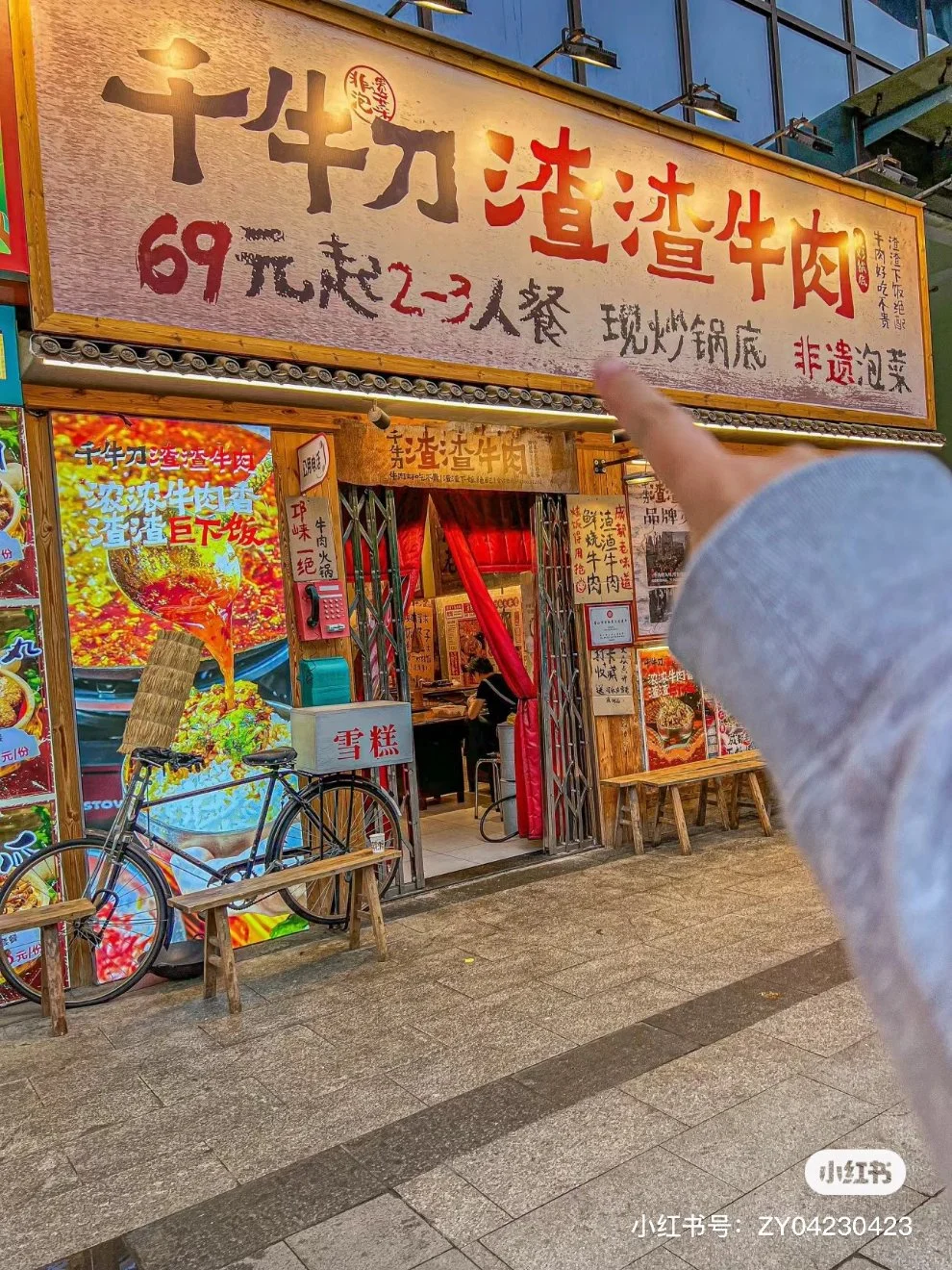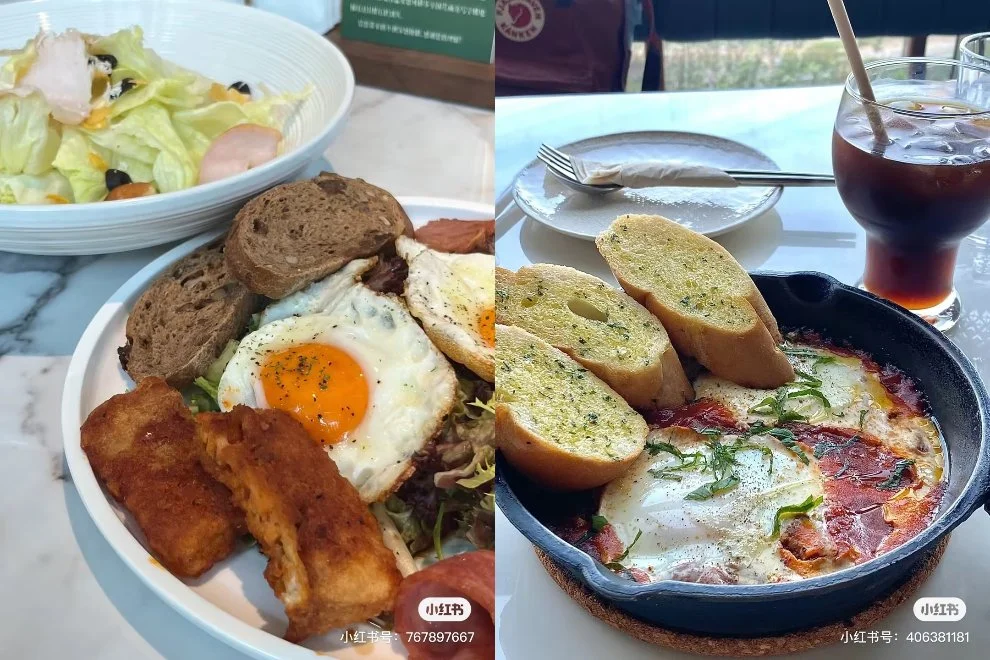Yoghurt’s unexpected pairing with regional delicacies in China
In the Chinese market, the trend of yoghurt becoming a snack is becoming increasingly apparent. Fresh yoghurt brands, like Blueglass, are regularly pairing their products with various foods such as fruit, chocolate, and milk to capture consumers' attention. On platforms like Xiaohongshu, creative yoghurt bowls have attracted many DIY enthusiasts looking to add fun to their lives.

The Blueglass yogurt and yogurt bowl. Images are from Xiaohongshu.
Yet fruit with yoghurt is common, and for something a little more adventurous, pop down to Taobao. If you have a taste for Chinese traditional dishes and a love for exploration, you can discover some intriguing niche yoghurt options. Perhaps inspired by the use of yoghurt with savoury and spicy curries in India, we are seeing some intriguing combinations in true China-style:
1. Jiānbing Guǒzi (Pancake roll)-flavoured yoghurt
Ppriced at ¥5.9 ($0.80) per sachet. As a famous snack from Tianjin, Jiānbing Guǒzi consists of a thin pancake and egg, complemented by sweet bean sauce, crispy chips, and chili sauce, creating a crispy texture with a savoury taste that is loved nationwide. Combining this complex flavour with yoghurt promises to be a unique experience.

Images are from Xiaohongshu and Taobao.
2. Bǎ zī ròu (Braised pork)-favoured yoghurt
Priced at ¥11.5 ($1.60) a pack. Bǎ zī ròu, a traditional dish from Shandong province, is made by simmering pork belly in soy sauce, resulting in a fragrant and non-greasy flavour that is somewhat similar to red-braised pork. Pairing this savoury dish with yoghurt offers a rather unusual combination.

Images are from Xiaohongshu and Taobao.
3. Jiāng shuǐ-flavoured yoghurt
Priced at ¥5 ($0.70) per sachet. A traditional beverage from Gansu province, jiāng shuǐ is made by cooked corn and soaking it in cold water for 5-6 days until it makes the flavour sour. This drink is known for its refreshing qualities in summer and its ability to help with bodily health. For people from Northwest China, this may be both a familiar and novel experience.

Images are from Xiaohongshu and Taobao.
4. Sichuan pepper-flavored yoghurt
Priced at ¥10 ($1.40) per tub. As an essential seasoning in Sichuan cuisine, Sichuan pepper provides a unique numbing sensation that pairs well with chilli peppers and is commonly found in everyday dishes from the Sichuan and Chongqing regions. The combination of this distinct numbing flavour with the sweetness of yoghurt is sure to challenge conventional perceptions of yogurt.

Images are from Baidu and Taobao.
5. Spicy strip-flavoured AD calcium milk
Priced at ¥3.5 ($0.50) per tub. While technically not yoghurt, AD calcium milk is a beloved beverage among those born in the 1990s in China. The combination of lightly sweet AD calcium milk with spicy strips may sound as contradictory yet eye-catching as Luckin Coffee's popular "Moutai-flavoured latte."

Images are from Xiaohongshu and Taobao.
Currently, all of the above products are available for sale on Taobao. Although it’s difficult to gauge their exact sales figures and the author hasn’t had the chance to sample them personally, for brands in today’s saturated high-end yoghurt market, leveraging familiar hometown memories for relatable marketing may resonate more deeply with consumers.
A concise yet holistic summary of March 2025’s key marketing developments in China, highlighting valuable insights and their implications for brands.
Robots are coming to China and will likely be the next big addition to the marketing mix
Mixue is now the largest fast food chain in the world by stores. It hasn’t got there by following the Western outsourcing model, rather building on a structure that takes advantage of China’s unique infrastructure
A concise yet holistic summary of February 2025’s key marketing developments in China, highlighting valuable insights and their implications for brands.
Xianyu has evolved from a second-hand marketplace into a hub for youth culture, side hustles, and digital innovation, offering valuable insights for foreign brands in China
Blind boxes are redefining value, experience, and ethics in consumption. The intersection of affordability, gamification, and sustainability is a powerful formula that brands can learn from and adapt.
Jack Ma launched New Retail with a roar in 2016 starting a scramble for the New Retail crown on both sides of the Pacific. The buzzword has since fizzled out and Alibaba has divested in much of its bricks & mortar retail properties, but the need to rethink retail is more important than ever. Here's why...
Despite being winter, Naimi's novel fried chicken-looking ice creams are flying out of the chiller. Their success provides many valuable lessons for brands selling in China
From adapting flavours to creating viral moments, Oreo has continually evolved to meet the changing tastes and lifestyles of Chinese consumers, transforming the foreign brand into a household favourite.
Highlights of a study proposing solutions for the evolving landscape of China's consumer market amidst economic uncertainties and shifting consumer behaviours.
As the typically unexciting pharma industry proves, packaging innovation can breathe life into even the most mundane product categories.
Chinese sanitary pad brands face backlash over misleading lengths and pH standards akin to tablecloths, sparking consumer boycotts and calls for reform. The willingness to talk about once-taboo products shows a new era of consumer pushback and could provide advantages for cross border products
How are China's blind box phenomenon and innovative product strategies are reshaping consumer behavior? Learn how brands can stay relevant in China's fast-paced market with creative, cost-effective approaches to meet evolving demand.
China's seniors are one of the most anticipated demographics, yet one of the least tapped by foreign brands. Preferences, behaviour and influences are all changing, helping to make them more accessible for foreign brands
Although summer has come to an end in China, the enthusiasm for ice cups remains strong. Coffee ice cubes and fruit-flavoured ice ball cups have further encouraged people to explore DIY mixers and enhance their beverage experiences.
Traditionally, yoghurt has been seen as a symbol of purity, health, and deliciousness. But what would happen if we blended it with the flavours of some famous regional Chinese cuisines?
Founded in 2017, M Stand has continually evolved with its unique aesthetic and comprehensive innovations, positioning itself as more of a lifestyle brand than a coffee chain.
With the Mid-Autumn Festival approaching, mooncakes—an essential traditional treat—are once again showcasing innovative and exciting variations. This round up of intriguing and unusual mooncakes may provide inspiration for product development beyond the traditional treat!
On September 10, 2024, Apple and Huawei held events on the same day to unveil their flagship products: the iPhone 16 series and the Mate XT Master Series. The impressive presentations left people in awe and suggested that the battle for high-end smartphones in China might just be getting started.
With the advancement of AI, many industries have successfully reduced costs and increased efficiency, and the food & beverage sector has seen the emergence of many innovative and data-driven products. However, are AI-developed foods really as good as we imagine yet?
As the “lying flat” lifestyle grows among Chinese workers looking to unwind, more urbanites are seeing the allure of cruises return. This stress-free approach to travel fits perfectly with the cruise experience, leading more Chinese to choose cruises as their ideal escape.
In April, Lin Yuanchun birch water became the top-selling beverage on Douyin, surpassing brands like Coca-Cola and Oriental Leaf. Birch water continues to gain popularity, driven by its health benefits and the aggressive marketing on social media.
You can now book an at-home milk tea service! In Chengdu and Suzhou, some milk tea shops are launching this new service. What is driving the popularity of this new service?
Just like us, pets need to beat the heat during the sweltering summer months. From stylish cooling mats and pads, to ice collars and breezy apparel, a wave of functional and fashionable products has been heating up China's pet supplies market, creating promising seasonal opportunities.
Durian-related food and drinks are currently getting a lot of attention on Chinese social media. Here are some examples of how brands and restaurants are incorporating durian into their offerings
This summer, the combination of mint and chocolate has become a trending flavour in China following its popularity in other countries. Various brands are introducing mint chocolate-flavoured products in drinks, ice cream, bakery and cakes.
As competition in the Chinese dining market intensifies once again, a number of low- and mid-range brands are directly writing their prices on their storefronts. Although this move is direct, the results have seen brands begin to imitate this set of marketing methods.
This spring, many upscale dining brands have started offering breakfast options, aiming to attract more customers by expanding their business lines.
A bakery in Hangzhou drew many customers with its "9.9 Yuan" marketing slogan in May. Since then, numerous low-price bakeries have popped up across the country.
China big ecommerce festivals act as a barometer for consumer sentiment, but this year’s 618 also provides wider lessons into what is working with Chinese consumers right now






























